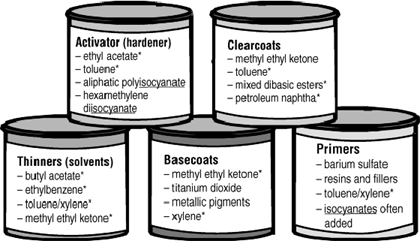Choosing the Right Gloves For Painting Cars
Why Should Car Painters Wear Gloves?What Is The Most Important Consideration When Selecting Gloves?
What Chemicals Should Gloves Protect Against?
What Type Of Glove Makes The Most Sense For Car Painters?
How Often Should Painters Change Their Gloves?
How Can I Get More Information On Chemical-Protective Gloves?
Why should car painters wear gloves?
Gloves help keep you safe and healthy! Chemicals in paints can pass through skin and enter your body. Some of these chemicals cause health problems, even in small amounts. To protect yourself, wear chemical-protective gloves every time you handle paint materials, and especially during paint mixing, spraying, and gun cleaning. Painters should also wear chemical-resistant clothing, eye protection, and an appropriate respirator as part of a complete protection program.
Note: This guide provides insights into some of the chemical-protective gloves presently available that may be used by auto refinishers. It is not intended to be used as a glove selection guide.
back to top | Automotive Refinishing Partnership Home
What is the most important consideration when selecting
gloves?
Above all, the gloves you use must provide a protective barrier to the toxic chemicals in paints. Of primary concern are solvents, which typically have the fastest glove pass through times and pose serious health concerns. Solvents also damage your skin, which makes it easier for chemicals such as isocyanates to enter your body. Isocyanates are strong irritants and can cause allergic reactions to the skin and internal organs. Gloves that protect against solvent exposure should provide a barrier to other chemicals as well.
back to top | Automotive
Refinishing Partnership Home
What chemicals should gloves protect against?
Painters need to protect their hands, and other parts of their bodies, from a wide variety of toxic chemicals used in auto refinishing. Thinners, primers, basecoats, and clearcoats all contain dangerous chemical ingredients. The following lists indicate some typical ingredients in paint coatings:
Of course, the chemicals in paint materials vary from one paint manufacturer to the next. Painters and shop owners should refer to the manufacturer's material safety data sheets (MSDSs) for a complete list of product ingredients.
The ingredients with stars (*) are all organic solvents -- common chemicals in paint coatings.
Remember: paint shops use many toxic chemicals. Your gloves must
protect against all of them!
back to top | Automotive
Refinishing Partnership Home
What type of glove makes the most sense for car painters?
 Don't
make your choice based on price alone! All gloves do not provide the same
level of protection. Latex gloves, for example, offer little or no protection
because they rapidly degrade after being exposed to many chemicals found
in paint materials. Latex gloves are not a good choice for most painting
tasks.
Don't
make your choice based on price alone! All gloves do not provide the same
level of protection. Latex gloves, for example, offer little or no protection
because they rapidly degrade after being exposed to many chemicals found
in paint materials. Latex gloves are not a good choice for most painting
tasks.
Nitrile gloves, in contrast, provide a better barrier to paints and organic
solvents—the chemicals that are some of the toughest on gloves. Because
they protect well and are durable, nitrile gloves (which cost about $10.00
for a box of 100 pairs) offer good value for your safety dollar. Of course,
even nitrile gloves would not provide adequate protection against all
chemicals for all tasks. 
Certain strong solvents used in paints and for clean-up, like methyl ethyl ketone (MEK), pass through nitrile gloves. Nitrile gloves should not be used for tasks where direct immersion of gloves in MEK lasts longer than a few minutes. Other glove types, like butyl rubber, provide a stronger barrier to MEK and similar chemicals, but these gloves are very expensive and might not offer painters the "feel" they need for most tasks.
Ultimately, shop owners should work with their painters and glove distributors to identify the right gloves: ones that protect against auto refinishing chemicals, fit comfortably, suit the task, and are a good protection value.
Remember: In a paint shop you're exposed to many chemicals that pass through gloves at varying rates. The right glove must protect you from the chemicals that penetrate gloves fastest.
back to top | Automotive Refinishing Partnership Home
How often should painters change their gloves?
When to change gloves depends on the glove type, thickness, and condition of use. It's always best to consult with the glove manufacturer to find out how often gloves should be changed. Before any task, painters should carefully inspect their gloves for cuts, tears, or punctures. Painters should immediately change gloves that show signs of wear!
back to top | Automotive
Refinishing Partnership Home
How can I get more information on chemical-protective
gloves?
Talk to glove manufacturers and distributors, listed in most phone directories. These companies offer technical advice—and often free samples—to prospective clients. Your distributor of paints and personal protective equipment might also provide these services.
Consult with Mary Cushmac (202-564-8803, cushmac.mary@epa.gov)
or David DiFiore (202-564-8796, difiore.david@epa.gov)
of the DfE Project Team.
back to top | Automotive Refinishing Partnership Home
![[logo] US EPA](https://webarchive.library.unt.edu/eot2008/20090510000800im_/http://www.epa.gov/epafiles/images/logo_epaseal.gif)
